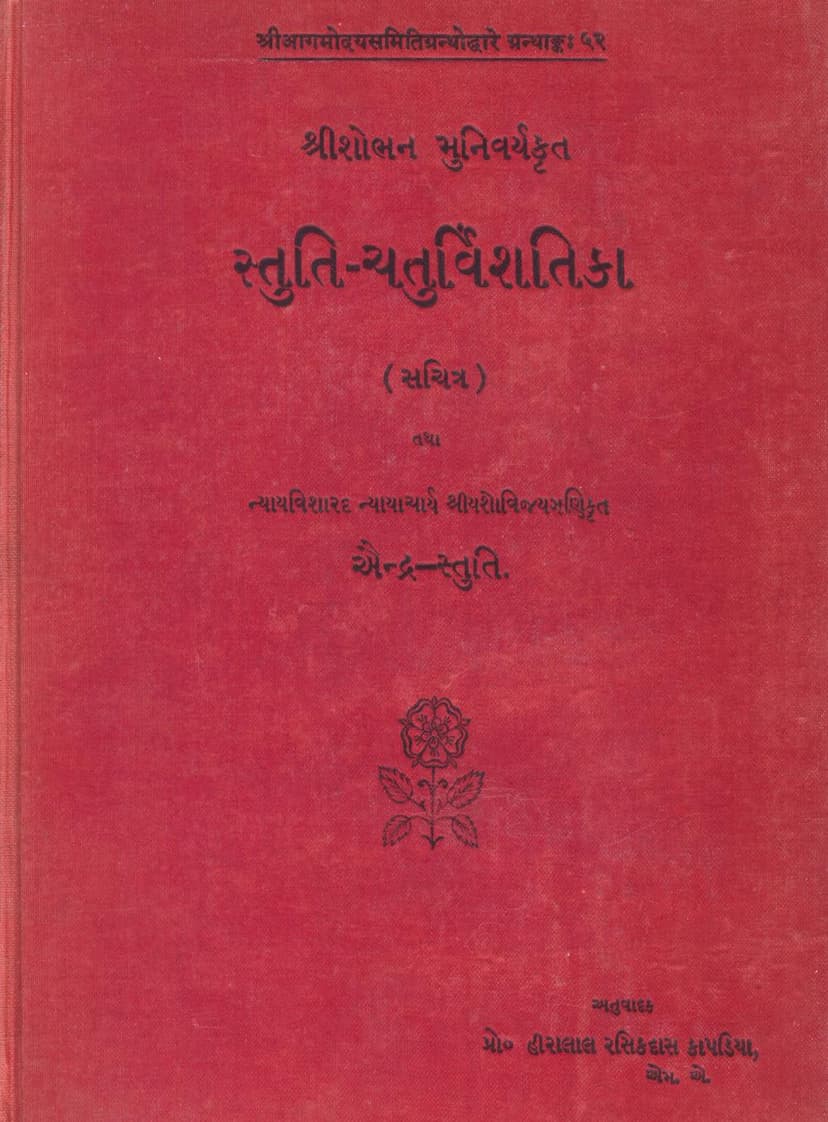Stuti Chaturvinshatika Sachitra
Added to library: September 2, 2025

Summary
This Jain text, "Stuti Chaturvinshatika Sachitra," authored by Hiralal R Kapadia and published by Agmoday Samiti, is a scholarly work presenting the "Stuti Chaturvinshatika" by the revered Muni Shree Shobhan, accompanied by its commentary by the great poet Dhanpal and an introductory explanation (Avachuri) by earlier Munis. The book also includes "Aindra Stuti" by the learned Nayacharya Shree Yashovijayji as an appendix.
Key Features and Content:
- Comprehensive Presentation: The book is meticulously prepared with the original Sanskrit verses of the Stuti Chaturvinshatika, a commentary (Tika) by Dhanpal, an Avachuri by earlier sages, and the Aindra Stuti by Yashovijayji.
- Gujarati Translation and Commentary: Professor Hiralal R Kapadia, a renowned translator, has provided a Gujarati translation and detailed commentary (Vivechan) for the text, making it accessible to a wider audience.
- Illustrative Content: The title itself, "Sachitra," indicates that the book is illustrated, featuring reproductions of deities and other significant figures from Jain iconography, adding a visual dimension to the textual content.
- Editorial and Scholarly Apparatus: The publication includes extensive scholarly material such as:
- A preface (Aamukh) and introduction (Upoadghat) detailing the life and literary contributions of Shree Shobhan Muni, along with an analysis of the poetry.
- A list of manuscript copies used.
- A guide to the texts used for clarification (Spashtikaransadhani-bhut-granth-suchi).
- A glossary (Shabd-kosh) and index of verses (Padya-anu-kramanika).
- Content of the Stuti Chaturvinshatika: The text comprises 96 verses, each dedicated to praising one of the 24 Tirthankaras. The structure generally follows a pattern where each Tirthankara's main hymn is followed by verses praising deities associated with the Shasan (governing deities) or other important Jain concepts. For instance, the fourth verse of each hymn often praises a specific deity, such as Vidya Devis, Yakshas, or Shanti Devi. The author notes that some deities like Rohini, Kali, and Ambika are praised multiple times.
- Analysis of Poetic Elements: The work delves into the literary aspects of the Stuti, analyzing the author's mastery of Sanskrit grammar, the variety of meters used (18 in total, including Anushtubh, Indravajra, Upajati, Druvilambita, etc.), and the intricate wordplay and alliteration employed.
- Biographical and Historical Context: The introduction provides a detailed biographical account of Shree Shobhan Muni, discussing his lineage, education, and the historical context of his writings. It also addresses the challenges in pinpointing his exact time period due to differing accounts in various Jain texts.
- The Agamodaya Samiti: The publication is credited to the Agamodaya Samiti, an organization dedicated to publishing and preserving ancient Jain scriptures. The preface elaborates on the Samiti's founding, objectives (promoting the study and dissemination of Agamas), and operational details, including its offices and publications.
- Inclusion of Aindra Stuti: The appended "Aindra Stuti" by Shree Yashovijayji, a prominent Jain scholar and philosopher, adds further depth and value to the collection.
Overall Summary:
"Stuti Chaturvinshatika Sachitra" is a significant publication for Jain literature. It offers a critical edition of Shree Shobhan Muni's devotional hymns praising the 24 Tirthankaras, enriched with classical commentaries and scholarly analysis by Professor Hiralal R Kapadia. The inclusion of detailed introductions, explanations, illustrations, and the appended Aindra Stuti makes it a valuable resource for understanding Jain devotional literature, philosophy, and poetic artistry. The book reflects the Agamodaya Samiti's commitment to preserving and promoting Jain heritage.